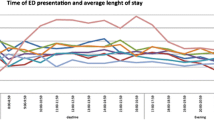Abstract
As emergency department (ED) crowding continues to worsen, many visits are at academic referral hospitals. As a result, engaging specialty services will be essential to decompressing the ED. To do this, it will be important to understand which specialties to focus interventions on for the greatest impact. To characterize the ED utilization of non-surgical adult patients with an ambulatory specialist who were seen and discharged from the ED. Retrospective cohort study of all consecutive patients currently under the care from a specialist presenting to an urban, university affiliated hospital between 01 January 2015 and 31 December 2016. The identification of ED visits attributable to specialists was based on the primary diagnosis of ED visits and the frequency of visit with specialists within a given timeframe. Only patients who were discharged directly from the ED were included in the analysis. There were 29,853 ED visits by patients currently under the care of a specialist during the study period. 17.76% of these visits were related to the medical specialty of the specialist. Of these visits, 41.73% occurred during office hours, and 24.81% occurred during weekends. The specialties with the largest proportion of ED visits related to their specialty was cardiology, gastroenterology, and pulmonary, respectively. Nearly 18% of all patients that have a specialist and are treated and discharged from the ED present with a diagnosis related to their specialist’s practice. This may indicate that there is a role for specialty service to play in decreasing some ED utilization that may be appropriate for the out-patient clinical setting. By focusing attention on specific specialties and interventions targeted during office hours, there may be an opportunity to decrease ED utilization.


Similar content being viewed by others
References
Bernstein SL, Aronsky D, Duseja R et al (2009) The effect of emergency department crowding on clinically oriented outcomes. Acad Emerg Med 16(1):1–10. https://doi.org/10.1111/j.1553-2712.2008.00295.x
Trzeciak S, Rivers EP (2003) Emergency department overcrowding in the United States: an emerging threat to patient safety and public health. Emerg Med J 20(5):402–405. https://doi.org/10.1136/emj.20.5.402
Hoot NR, Aronsky D (2008) Systematic review of emergency department crowding: causes, effects, and solutions. Ann Emerg Med 52(2):126–136. https://doi.org/10.1016/j.annemergmed.2008.03.014
Carter EJ, Pouch SM, Larson EL (2014) The relationship between emergency department crowding and patient outcomes: a systematic review. J Nurs Scholarsh 46(2):106–115. https://doi.org/10.1111/jnu.12055
Rodi SW, Grau M, Orsini CM (2006) Evaluation of a fast track unit: alignment of resources and demand results in improved satisfaction and decreased length of stay for emergency department patients. Qual Manag Health Care 15(3):163–170. https://doi.org/10.1097/00019514-200607000-00006
Considine J, Kropman M, Kelly E, Winter C (2008) Effect of emergency department fast track on emergency department length of stay: a case-control study. Emerg Med J 25(12):815–819. https://doi.org/10.1136/emj.2008.057919
Goodacre SW (2013) Point-of-care testing may reduce length of stay but not Emergency Department crowding. Ann Emerg Med 61(2):153–154. https://doi.org/10.1016/j.annemergmed.2012.09.001
Jang JY, Do SS, Lee EJ, Park CB, Song KJ (2013) Singer AJ Use of a comprehensive metabolic panel point-of-care test to reduce length of stay in the Emergency Department: a randomized controlled trial. Ann Emerg Med 61(2):145–151. https://doi.org/10.1016/j.annemergmed.2012.07.021
Honigman LS, Schuur JD, Chambers JG, Pines JM (2014) Adoption of interventions to reduce emergency department crowding from 2007 to 2010. Ann Emerg Med 64(4):S74–S75. https://doi.org/10.1016/j.annemergmed.2014.07.233
Pitts SR, Carrier ER, Rich EC, Kellermann AL (2010) Where Americans get acute care: increasingly, it’s not at their doctor’s office. Health Aff 29(9):1620–1629. https://doi.org/10.1377/hlthaff.2009.1026
Freid V, Bernstein A (2010) Health Care utilization among adults aged 55–64 years: how has it changed over the past 10 years? NCHS data brief 32:1–8
Kim J, Yun B, Aaronson E, Kaafarani H, Linov P, Rao S (2018) Weilburg J LJ (2018) The next step to reducing Emergency Department (ED) crowding: engaging specialist physicians. PLoS One 13:e0201393
Patel AD, Wood EG, Cohen DM (2017) Reduced Emergency Department utilization by patients with epilepsy using QI methodology. Pediatrics 139(2):e20152358. https://doi.org/10.1542/peds.2015-2358
Lee J, Greenspan PT, Israel E et al (2016) Emergency Department utilization report to decrease visits by pediatric gastroenterology patients. Pediatrics 138(1):e20153586–e20153586. https://doi.org/10.1542/peds.2015-3586
Yun BJ, Aaronson EL, Israel E, Greenspan P, Rao S, Lee J (2017) Cost savings associated with decreased emergency department utilization by reporting emergency department visits to specialists. Am J Emerg Med. https://doi.org/10.1016/j.ajem.2017.04.050
HCUP Clinical Classifications Software (CCS) for ICD-9-CM. Healthcare cost and utilization project (HCUP). 2006-2009. Agency for Healthcare Research and Quality, Rockville, MD. www.hcup-us.ahrq.gov/toolssoftware/ccs/ccs.jsp
Lee J, Israel E, Weinstein H et al (2017) Using physician-level Emergency Department utilization reports to address avoidable visits by patients managed by pediatric specialists. Hosp Pediatr 7(11):686–691. https://doi.org/10.1542/hpeds.2017-0054
Fowles JB, Fowler EJ, Craft C (1998) Validation of claims diagnoses and self-reported conditions compared with medical records for selected chronic diseases. J Ambul Care Manag. https://doi.org/10.1097/00004479-199801000-00004
Fowles JB, Fowler E, Craft C, Mccoy CE (1997) Comparing claims data and self-reported data with the medical record for pap smear rates. Eval Health Prof. https://doi.org/10.1177/016327879702000305
Tyree PT, Lind BK, Lafferty WE (2006) Challenges of using medical insurance claims data for utilization analysis. Am J Med Qual. https://doi.org/10.1177/1062860606288774
Author information
Authors and Affiliations
Corresponding author
Ethics declarations
Conflict of interest
Jarone Lee has two unrelated disclosures to the present work. Dr. Lee is a consultant for both Butterfly Network, Inc. and Felis Medical, Inc.
Statements on human and animal rights
All procedures performed in studies involving human participants were in accordance with the ethical standards of the institutional and with the 1964 Helsinki declaration and its later amendments or comparable ethical standards.
Informed consent
For this study, formal consent was not required.
Additional information
Publisher’s Note
Springer Nature remains neutral with regard to jurisdictional claims in published maps and institutional affiliations.
Rights and permissions
About this article
Cite this article
Aaronson, E.L., Kim, J., Hard, G.A. et al. Emergency department visits by patients with an internal medicine specialist: understanding the role of specialists in reducing ED crowding. Intern Emerg Med 14, 777–782 (2019). https://doi.org/10.1007/s11739-019-02051-1
Received:
Accepted:
Published:
Issue Date:
DOI: https://doi.org/10.1007/s11739-019-02051-1




